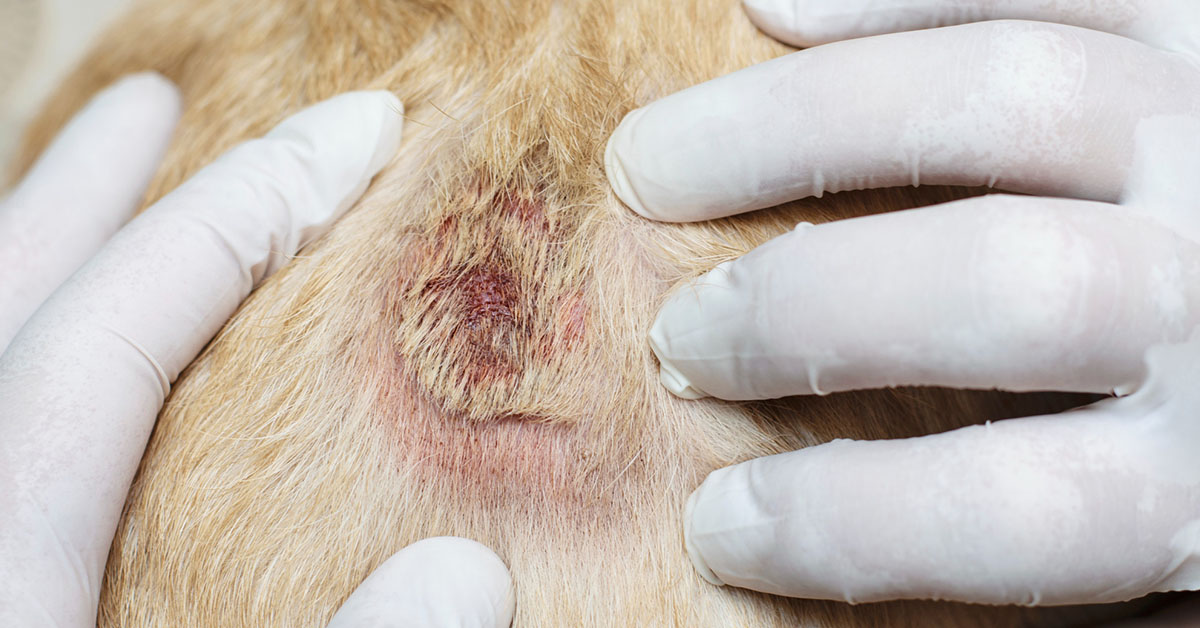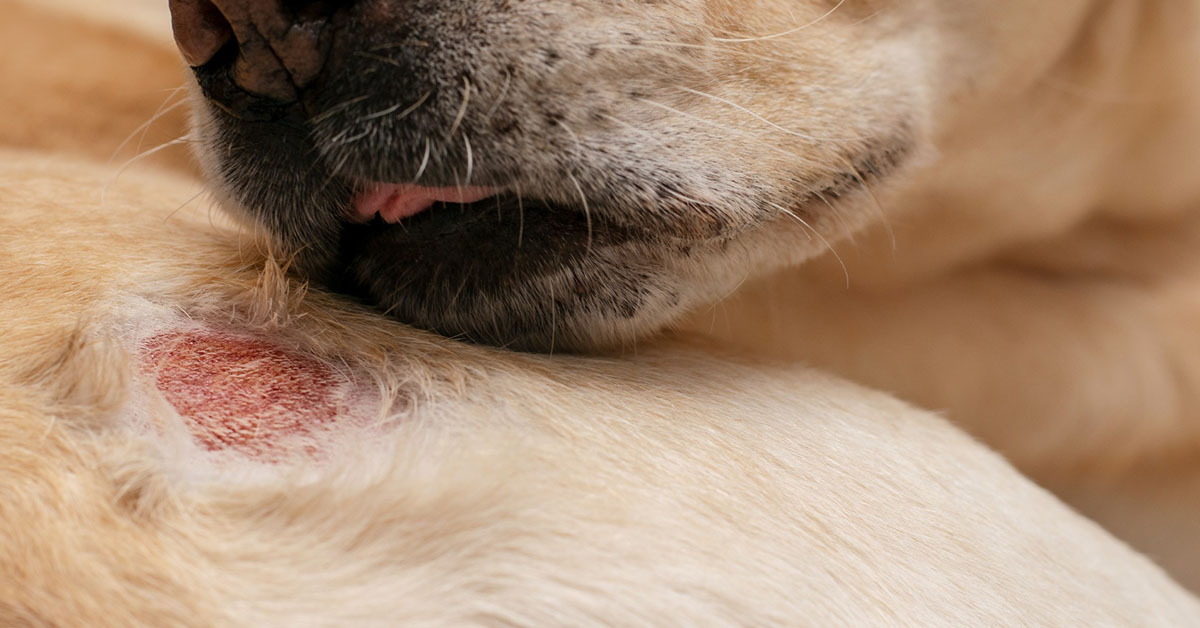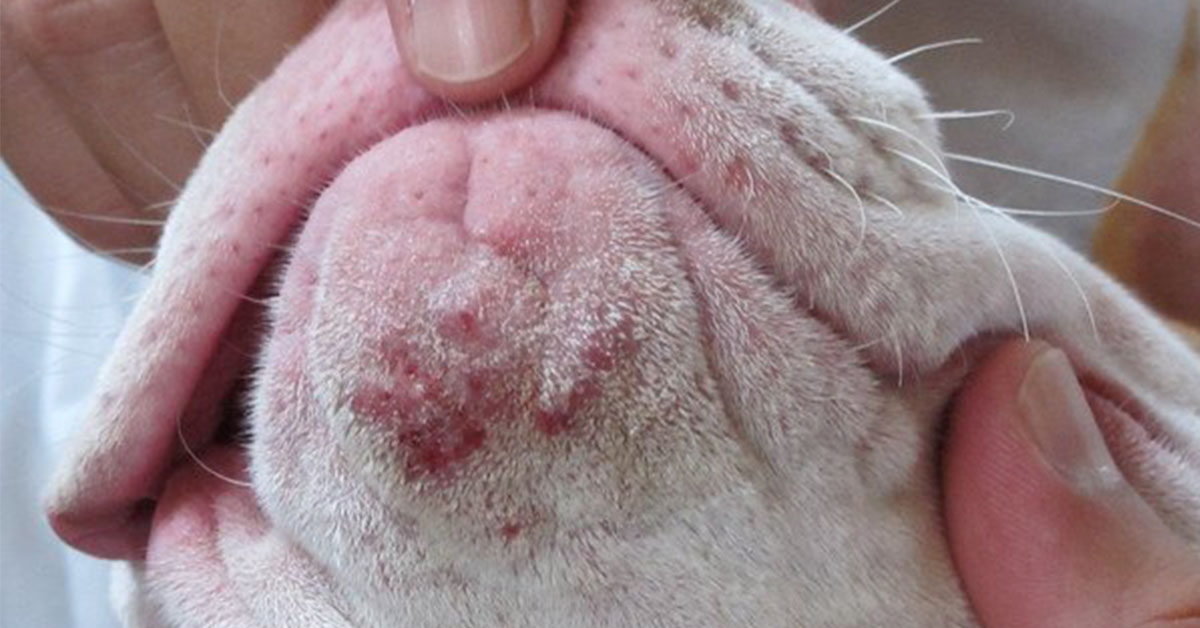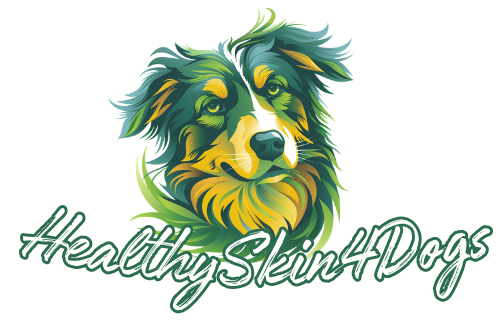Skin care is essential for dogs, yet we often overlook it. A dog’s skin protects him from external threats, so keeping it healthy and intact is crucial. Therefore, this guide will explore the most common skin conditions in dogs affecting your beloved canine companions.
You should be aware of what causes these skin conditions in dogs and how to treat them. Early detection and treatment can help keep our furry friends healthy and happy. Let’s explore dog skin problems and learn practical ways to keep your canine companion happy and itch-free.
Most Common Skin Conditions in Dogs
Various factors can cause dog skin conditions, including allergies, infections, parasites, and hormonal imbalances. Inflammation, itching, redness, and skin lesions are often signs of these conditions. You should be aware of the following skin conditions in dogs:
1. Allergies

Dog allergies can result from food, environmental factors like pollen or dust, or flea saliva. Symptoms include itching, redness, inflammation, hair loss, and secondary skin infections.
Several ways can be used to treat allergic reactions, including diet changes, hypoallergenic diets, antihistamines, steroids, or immunotherapy. Furthermore, parasite control and environmental management are crucial for managing allergies in dogs.
2. Hot Spots (Acute Moist Dermatitis)
Hot spots, also known as acute moist dermatitis, are localized areas of inflamed, infected skin caused by excessive licking, scratching, or moistness. The most common symptoms of this condition are redness, pain, swelling, and oozing lesions. To treat hot spots, you’ll typically have to clean the affected area, apply topical medications or antibiotics, and treat underlying causes like allergies or parasites.
3. Mange
Mange is a skin condition in dogs caused by mites. Sarcoptic and demodectic mange are the most common types. This condition causes severe itching, hair loss, crusting, and lesions on the skin. Depending on the type of mange, you can treat with topical medications, oral medications, and environmental decontamination to prevent re-infestation.
4. Bacterial Infections (Pyoderma)
In dogs, red, pustular lesions and skin inflammation characterize the pyoderma bacterial skin infection. The most common causes of Pyoderma are allergies, trauma, or immune system disorders. Treatment for this infection is most often antibiotics, topical antiseptics, and addressing predisposing factors.
5. Folliculitis
Folliculitis is an inflammation of the hair follicles caused by bacterial or fungal infections in dogs. Symptoms include redness, swelling, pustules, and hair loss around the affected follicles. It’s usually treated with topical or oral antibiotics, antifungal medication, and medicated shampoos.
6. Yeast Dermatitis

Yeast dermatitis is a fungal infection caused by an overgrowth of Malassezia yeast on dogs’ skin. This condition causes greasy, malodorous skin as well as itching, redness, and crusty lesions. Treatment includes antifungal medications, medicated shampoos, and addressing underlying factors like allergies or hormonal imbalances.
7. Ringworm
Ringworm is a contagious fungus that affects dogs’ skin, hair, and occasionally nails. Your dog will get circular, scaly lesions with clearing in the middle, itchiness, and hair loss. You can treat this condition with antifungal medications, environmental decontamination, and strict hygiene measures.
8. Flea Allergy Dermatitis
Flea allergy dermatitis is an allergic reaction to flea saliva that causes intense itching and inflammation of the dog’s skin. Excessive scratching, redness, and hair loss are common symptoms, especially over the lower back, tail base, and hind legs.
Flea prevention and treatment include using flea preventatives regularly, managing the environment, and addressing symptoms.
9. Seborrhea
Seborrhea is a disorder of the sebaceous glands, resulting in excessive oiliness (oily seborrhea) or dryness (dry seborrhea) of the dog skin and coat. There are a variety of symptoms, including greasy or flaky skin, odor, and itching. Treatment options include medication shampoos, dietary supplements, and managing underlying causes, such as hormonal imbalances.
10. Canine Acne

Canine acne is a common skin condition characterized by comedones (blackheads), papules, and pustules on the chin and lips. The symptoms may include redness, swelling, and occasionally discomfort or pain.
In addition to topical therapies like benzoyl peroxide or antibiotics, you should address underlying factors like lousy grooming habits. If you take action early, you can prevent secondary infections and discomfort.
What Skin Conditions Should I Be Aware of When Caring for My Dog’s Skin?
When caring for your dog’s skin, be mindful of common conditions like allergies, hot spots, and dermatitis. Recognizing these issues early can prevent discomfort and further complications. Avoid common dog skin care mistakes, such as using human products or overlooking signs of irritation, to ensure your canine companion stays healthy and comfortable.
How to Treat Skin Conditions in Dogs
The most effective way to manage dog skin conditions is through timely diagnosis and proper veterinary care. Veterinarians use various diagnostic tools and techniques to determine what’s wrong with dogs’ skin.
During a diagnosis, your vet might perform a skin scraping, cytology, allergy test, and blood test to detect underlying illnesses. Following a diagnosis, veterinarians may recommend topical or oral medications, medicated shampoos, dietary changes, or environmental management strategies.
The veterinarian can adjust treatment plans as necessary and address any new concerns as appropriate during follow-up appointments. Ultimately, only a veterinarian can provide pets with the best skin care, ensuring they live a much more comfortable and enjoyable life.
Preventive Measures for Skin Conditions in Dogs
Preventing common skin conditions in dogs and promoting overall health requires proactive measures. Some of the preventive measures are:
Regular Grooming Practices
Regular grooming is essential for keeping your dog’s skin and coat healthy. Brush your dog’s coat to remove loose hair, dirt, and debris. Washing your dogs with a gentle, dog-friendly shampoo keeps their skin clean and free of irritations.
In addition, trimming your dog’s nails regularly prevents overgrowth, which can cause discomfort and even skin problems.
Balanced Diet
Feeding your dog a balanced and nutritious diet for good skin health is essential. Ensure your dog gets high-quality protein, omega-3 and omega-6 fatty acids, vitamins, and minerals.
These nutrients keep your skin’s natural barrier functioning, support your immune system, and reduce allergic reactions and inflammation. Your veterinarian can advise you on the best diet for your dog based on his specific needs.
Environmental Management
Keeping dogs away from allergens and parasites is the key to preventing skin issues. Clean your house regularly, vacuum carpets, wash bedding, and remove dust and debris.
Air purifiers can help reduce airborne allergens like pollen, mold spores, and dust mites, especially during allergy season. Effective flea control measures, such as topical treatments, oral medications, or flea collars, can also prevent flea infestations.
Regular Veterinary Check-ups
Regularly check your dog’s health and address any potential skin issues immediately. During check-ups, veterinarians can assess your dog’s skin condition and detect early signs of skin problems.
They may also recommend specific products or treatments based on your dog’s needs. With the help of your veterinarian, you can develop a comprehensive preventive care plan for your dog.
The Takeaway
You should always take care of your dog’s skin to keep it happy and healthy. Regular vet checks and preventive measures can help you proactively prevent common skin conditions in dogs. The right grooming habits, a nourishing diet, and managing environmental factors all enhance their skin’s resilience. Don’t forget early detection and intervention.









